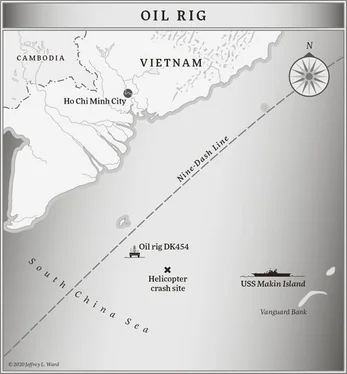They were, of course, far from defenseless. Sun had never personally seen it, but the Russian Typhoon-class submarine was said to be large enough to have its own sauna and pool. Sun laughed at the thought. With the flick of his hand, he could turn his entire boat into a sauna and have the crew swimming in their own sweat.
The exercise had not been a complete waste of time. Simply being at sea was good training for his youthful crew.
Finally away, the last to leave, 771 was heading southwest by south off the Russian coastline, still in relatively shallow waters. She had yet to pass the point of Navarin, where the depth dropped to many thousands of meters—deeper and calmer. Here, they were in the growling gut of the Bering Sea—famous to Americans because of the bourgeois television program about crab fishing. The Bering was the birthplace of many a violent gale, and at this depth, Captain Sun Luoyang felt the roll of a confused sea shudder through his boat.
The three sick crewmen were all younger than twenty. The cook’s helper had it the worst, unable to keep down even a thin broth. The boy’s record said he was nineteen, but Sun suspected fifteen was closer to the mark, perhaps even younger. For a time, Sun thought he might even be a girl, a modern Mulan who had somehow slipped through training, to try her hand at the submarine service. Sun’s executive officer spoke to the chief, who spoke to the petty officers, who were quickly able to ascertain that, no, the cook’s helper was indeed a boy, who badly missed his mother.
Steadying himself on the navigation table, the captain had the word passed to engineering to increase speed by two knots, straining the communication buoy tether, but hopefully smoothing out the ride. The odor on a submarine was an unpleasant one to begin with, but the ability to smell it disappeared within a few days. The three sick crewmen were adding new odors, making everyone, including the captain, fight the urge to gag a good deal of the time.
Seaman Wang, stationed at the communications booth, coughed quietly, hand to his mouth, as if he were about to vomit. He mumbled something unintelligible, large glasses illuminated, buglike, in the dull blue glow of his computer screen.
At nineteen years of age, and a recent graduate of the submariner academy in Qingdao, the boy was a worthy example of fortitude to be sure, but it would be problematic if he were to vomit all over the sensitive equipment.
Seasickness was bad enough on a surface vessel. Here, in this windowless metal tube that smelled of diesel fuel, sulfur, and flatulence, vertigo and nausea could be soul-crushing. The boat’s doctor—in truth, a submariner with six months of extra medical training—had given all three sick crewmen promethazine suppositories. This had apparently done little to ease Wang’s discomfort, but his perseverance was heartening. He was the very image of the submariners whom Captain Sun and the Motherland wanted to grow for their Red Star, Blue Water fleet. This stripling boy had set aside his roiling gut to man his station during the appointed time, no matter how sick he felt.
The boy’s hand shot to his mouth and he mumbled something again.
The chief of the watch barked at the boy to speak up, but the captain gave a slight shake of his head. He ran a tight ship, but no amount of discipline would chase away seasickness. It simply had to pass.
Commander Bai Jiahao, Sun’s executive officer, stepped closer to relay the incoming message.
“Communication buoy successfully deployed and operational,” he said. “Priority incoming from Fleet.”
Sun nodded. Both men knew that Fleet headed every message as Priority , so this notation did nothing to raise any alarms.
“Very well,” Sun said, waiting for the message to spit out of the small printer.
Three hours earlier—at a much more comfortable one hundred and twenty meters, 771 had received instructions telling her to surface as soon as practical for further communications. Only four countries in the world had antenna arrays large enough to send messages via extremely low frequency: China, Russia, India, and the United States. It was a point of pride with Captain Sun that China’s ELF array was the largest of them all. Almost as large as the American island of Manhattan, China’s massive installation essentially used the earth itself as an antenna with which to send its signals. Even so, communication through hundreds of feet of salt water was beyond difficult. The Blue Dragon had to pull two kilometers of wire behind her to receive the signals. ELF messages were one-way (the submarine could not respond) and they came in maddeningly slowly, on the order of a few characters per minute. For the most part, incoming signals were all the same—“ Prepare to communicate.” Essentially, this meant “We want to talk to you. Come shallow enough to deploy your antenna or communication buoy so that we may do so.”
When it was dark enough on the surface that Captain Sun felt the risk of his shadow being spotted via satellite was minimized, he instructed the officer of the deck to have the boat brought to thirty meters and deployed the communication buoy.
“Captain,” the XO said, stepping closer to pass him the printed message. The sub rolled to starboard, then righted herself. The XO, too, had to steady himself on the chart table.
“We are to alter course, sir.”
Sun snatched the flimsy paper away and scanned the characters.
He read the message again, more slowly this time, and then handed them to his XO, who barked new orders to retrieve the communication buoy and then turn the submarine around one hundred and eighty degrees.
With the order given, the XO lowered the paper so he could meet the captain’s eye.
“Sir, the Americans may not yet know our position, since we had to remain behind the others to finish repairs, but they will certainly hear, and in all likelihood see, us when we pass to the north through the Bering Strait.”
“Indeed,” Sun said.
A natural choke point, the Bering Strait was little more than eighty kilometers wide at its narrowest point. With an average depth of fifty meters, some areas were far shallower, leaving submarines visible to surveillance satellites or prowling P-3 Orion sub hunters. The Americans generally thought of the PLAN as a coastal submarine force, rarely venturing farther than the straits of Taiwan. They would be all too happy to discover a Chinese Dragon heading not just to coastal Russian waters, but for the Arctic Ocean.
The United States had placed sensitive hydrophones and other sensors on the floor of the Bering as well as other choke points around the world to monitor Soviet traffic. If one was to believe American propaganda—which Captain Sun did not—the Sound Surveillance System, or SOSUS, had been greatly curtailed after the Cold War, with only three devices still in place. Surely powers like the United States were growing their surveillance presence all around the world, not curtailing it. And that didn’t count the presence of Canadian or other listening devices.
The Americans would see them, but it could not be helped. PLAN Fleet Command knew what they were doing. They had issued the orders and Sun would comply with them.
“We will be apprised of our mission once we are well north of the strait,” Sun said. “Until then, set a course for these grid coordinates.”
The XO typed the latitude and longitude, laying in a series of plot-dots on the screen that would allow them to run as deep as possible, while navigating around obstacles like underwater mountains or the Diomede Islands that guarded the center of the Bering Strait. Finished, he tapped a spot on the chart off the coast of Alaska, a thousand kilometers north of the strait.
Читать дальше











![Александр Ирвин - Tom Clancy’s The Division 2. Фальшивый рассвет [litres]](/books/417744/aleksandr-irvin-tom-clancy-s-the-division-2-falsh-thumb.webp)
